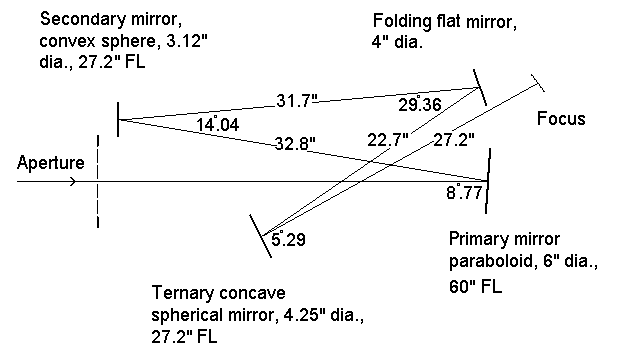
Ratio A=0.45, Radius of curvature of correcting spheres to radius of curvature of primary.
To my knowledge this is the first FSP telescope. It functions essentially the same as the standard Stevick-Paul* (which also uses 4 mirrors) except the design is more compact and with the slight increase in `A' the tilt of the focal plane is slightly decreased. An F15 design can use a spherical primary and would help further simplify construction.
The location and tilt angles of the mirrors cancel the on and off axis astigmatism and coma. Spherical aberration is removed by the primary, put back in by the secondary, and then finally removed by the ternary mirror. The distortion, image tilt and field curvature which remain along with standard higher order aberrations are relatively minor in nature.
By Bob Novack, 143 Wolfe Run Rd., Cranberry Twp. PA, 16066 Tel.(412) 828-9040 x220
*The Stevick-Paul off axis Reflecting Telescope, D. Stevick, ATMJ Issue 3, pp4-9 (1993)
I have had it (the FSP) to several star parties and have always received
favorable comments on the clarity of the view...I had QSP put their 96%
enhanced coating on all 4 of the mirrors. So far I have been very pleased
with the coating's performance and durability.
The image tilt has never been noticed by a member of the public. The
scope has many times been complimented as giving the clearest view on the
hill.
...unless one uses an image tilting lens the fastest SP for purely
visual use is about F10. The F10 to F15 range is still fast relative to
most other TCT's, except maybe Yolos and there one has to do fancy glass
work or have a warped sense of humor. A folded F12-F15 with 3 spheres may
be the easiest off-axis scope that can be made with reasonable speeds i.e.,
avoiding very long radii.
The FSP is baffled between the entering beam and the secondary with a
black velvet covered plate just inside the telescope entrance. Just a plain
black baffle is placed in the triangular area between the secondary and
the flat and runs parallel to the beam between the secondary and the flat.
The scope was used to look at Jupiter which was not far from the moon and
gave excellent results. The scope can be used on bright sunny days to look
around the neighborhood and gives clear contrasty images. The flat being
where it is to some extent serves as a baffle. I have chamfered off its
hip and have painted the visible part black. The edges of all the other
mirrors have also been blackened. Every little bit helps.
The flat was made after the primary was polished out and brought to a
sphere. I had two 4-inch tools left over from making a refractor doublet
so the sides were brought to the same measure with the spherometer. They
were polished and brought to good smoothness using the Ritchey-Common set
up using the spherical primary. I had previously made three 6-inch flats,
by the "one on the other method", and by comparison of the fringes and
solving the simultaneous equations, hopefully arrived at a 1/10 wave flat.
The two spherical mirrors were interferometrically compared, after the
concave was nulled, until the convex sphere gave good straight fringes.
The hardest part was parabolizing the F10 mirror. A sphere (at F10) is
almost good enough but not quite. The shadows on the Foucault test are
very soft. I used as narrow a slit as possible to enhance the shadow
contrast...Now that I know what I was getting into Al Woods was correct
by going a little longer (F12) and leaving his mirror a sphere. However
it was a good experience.
Bob Novack
Curator: Hartmut Frommert
[contact]
[Schiefspiegler Home]
[SEDS]